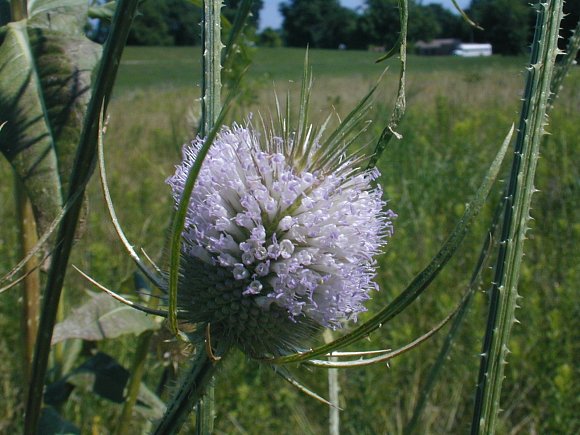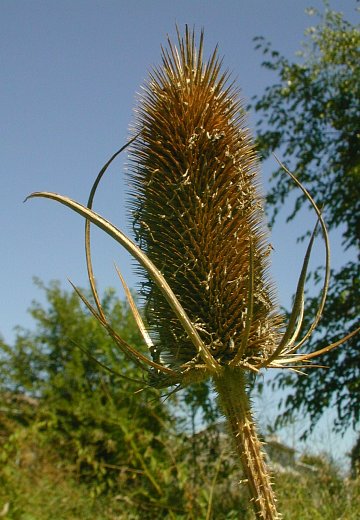Description: This herbaceous biennial plant consists of a low rosette of basal leaves during the first year. These basal leaves are up to 12" long and 3" across, oblanceolate, and crenate. During the second year, Teasel develops stems with opposite leaves, becoming 2½–6' tall; it branches occasionally and is rather lanky. The hairless stems are pale green to reddish green; they have scattered white prickles and flat longitudinal ridges. The opposite leaves are up to 12" long and 3" across; they are green, yellowish green, or reddish green, lanceolate to linear-lanceolate, ascending to spreading, and rather stiff in texture. Their margins are smooth, slightly prickly, or irregularly toothed. On the upper surface of each leaf, there is a white central vein, while on the lower surface this vein has stout prickles. The lower opposite leaves are sessile, while the upper opposite leaves are perfoliate or clasping. All leaves are hairless.

Each upper stem terminates in a stout spike of flowers up to 4" long and 1½" across; the long flowering stalk is naked and prickly. Initially, each floral spike is ovoid in shape, but it later elongates and becomes oblongoid. At the base of each floral spike, there are several linear bracts up to 6" long that curve upward, surrounding the spike. These bracts have scattered prickles on their sides and undersides. Narrow tubular flowers and their buds are densely crowded together all around the spike. These flowers begin to bloom in the middle of the spike, but later they bloom in separate rings toward the top and bottom of the spike. The corolla of each flower is narrowly tubular and about ½" long; it has 4 outer lobes that are small and rounded. The corolla is usually pale purple or lavender toward the outer lobes, but it is white toward the base. Each flower has 4 exerted stamens with white filaments and pale purple or lavender anthers. The calyx is tiny and insignificant. At the base of each flower, there is a bract originating from the receptacle that is straight and about the same length as the flower. This bract is usually pale green, stiff, and linear in shape. However, the bracts of the receptacle toward the apex of the floral spike are significantly longer than the flowers. Like the flowers, these bracts are densely crowded all around the floral spike, providing it with a pincushion-like appearance after the flowers have withered away. The blooming period occurs from mid-summer into fall and typically lasts about 2 months for a colony of plants. After the blooming period, the entire plant gradually turns brown; the stalks and floral spikes persist through the winter. Each flower is replaced by a ridged 4-angled achene that is irregularly bullet-shaped and up to ¼" long. The root system consists of a stout taproot.

Cultivation:
The
preference is full or partial sun, mesic conditions, and mildly acid to
alkaline soil containing loam or clay-loam. The leaves are occasionally
bothered by powdery mildew.
Range & Habitat:
The non-native Teasel occurs occasionally in most areas of Illinois,
although it is
less common or absent in the NW section of the state (see Distribution
Map). It was introduced into North America from Eurasia.
Habitats include mesic
prairies (especially cemetery prairies), degraded grassy meadows,
savannas, woodland borders, pastures and abandoned fields, landfills,
roadsides, and waste areas. Teasel is an introduced species that can
invade high quality prairies and savannas. It is difficult to eliminate
from such habitats. Teasel also adapts readily to disturbed habitats.
Faunal Associations:
The nectar of the flowers attracts bumblebees and other long-tongued
bees, green metallic bees (Agapostemon spp.), bee
flies (Bombyliidae), butterflies, and skippers. Green metallic Bees
also collect
pollen. The caterpillars of Papaipema arctivorens
(Northern Burdock Borer Moth) bore through the stems of Dipsacus
spp. (Teasels). Mammalian herbivores shun the tough prickly
foliage of Teasel; even in overgrazed pastures, cattle nibble on the
outer tips of the leaves and little else. Except for flower-visiting
insects, the ecological value of this introduced species to wildlife is
low.

Photographic
Location:
A degraded floodplain meadow in Champaign, Illinois.
Comments:
The floral spikes from a cultivated form of Teasel were used to raise
the nap of woolen fabrics. This was possible because the bracts of the
receptacle in the cultivated form had hooked tips. In contrast, the
wild form of Teasel (as described here) has bracts with straight tips.
In horticulture, the dried floral spikes and their stalks are used in
dried flower arrangements. In the past, the floral spikes and stalks
were used as material in funereal wreaths, which were placed alongside
the gravestones of the deceased. This is one of the reasons why Teasel
occurs in cemetery prairies. With its spiny-looking floral spikes and
prickly stems, Teasel has a distinctive appearance that resembles no
native plant in Illinois. Another introduced species, Dipsacus
laciniatum (Cut-Leaved Teasel), can be distinguished from
ordinary Teasel by its pinnatifid leaves and straight bracts at the
base of the floral spikes; these bracts spread outward, but they do not
curl upward. The flowers of Cut-Leaved Teasel are white, while those of
ordinary Teasel are usually pale purple or lavender; however, strains
of Teasel with white flowers may occur in the wild. A scientific
synonym of Teasel is Dipsacus sylvestris.